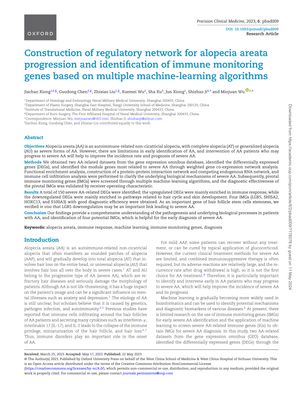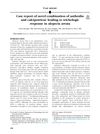Construction of Regulatory Network for Alopecia Areata Progression and Identification of Immune Monitoring Genes Based on Multiple Machine-Learning Algorithms
May 2023
in “Precision clinical medicine”

TLDR Researchers found four genes that could help diagnose severe alopecia areata early.
The study aimed to improve early identification and intervention for patients with alopecia areata (AA) at risk of progressing to severe forms such as total alopecia (AT) or generalized alopecia (AU). Researchers analyzed two AA-related datasets, identified 150 differentially expressed genes (DEGs) associated with severe AA, and used weighted gene co-expression network analysis to find module genes linked to severe AA. They conducted functional enrichment analysis, built a protein-protein interaction network, and analyzed immune cell infiltration to understand the biological mechanisms of severe AA. Multiple machine-learning algorithms were employed to identify four pivotal immune monitoring genes (IMGs)—LGR5, SHISA2, HOXC13, and S100A3—with good diagnostic efficiency. LGR5, a gene associated with hair follicle stem cell stemness, was found to be downregulated in severe AA. These findings offer a comprehensive understanding of AA pathogenesis and present four potential IMGs that could aid in the early diagnosis of severe AA.
View this study on academic.oup.com →
Cited in this study

research Ex Vivo Treatment with Allogenic Mesenchymal Stem Cells on Peripheral Blood Mononuclear Cells of Patients with Severe Alopecia Areata
Using healthy donor stem cells can potentially calm overactive immune cells and reduce inflammation in severe hair loss patients, offering a possible treatment method.
research Emerging Drugs for the Treatment of Alopecia Areata
New drugs for alopecia areata show promise but aren't universally effective, and hair loss often returns after stopping treatment.
research JAM-A Facilitates Hair Follicle Regeneration in Alopecia Areata Through Functioning as CeRNA to Protect VCAN Expression in Dermal Papilla Cells

research LGR5 Is a Conserved Marker of Hair Follicle Stem Cells in Multiple Species and Is Present Early and Throughout Follicle Morphogenesis
LGR5 is a common marker of hair follicle stem cells in different animals and is important for hair growth and regeneration.

research Comprehensive Analysis of LncRNA AC010789.1 Delays Androgenic Alopecia Progression by Targeting MicroRNA-21 and the Wnt/β-Catenin Signaling Pathway in Hair Follicle Stem Cells
The LncRNA AC010789.1 slows down hair loss by promoting hair follicle growth and interacting with miR-21 and the Wnt/β-catenin pathway.
research Immunology of alopecia areata
Alopecia areata, a type of hair loss, is likely an autoimmune disease with a genetic link, but its exact cause is still unknown.
research Frontiers in alopecia areata pathobiology research
The review suggests that other immune cells besides CD8+ T cells may contribute to alopecia areata and that targeting regulatory cell defects could improve treatment.
research Alopecia areata: A multifactorial autoimmune condition
Alopecia areata is an autoimmune disease causing patchy hair loss, often with other autoimmune disorders, but its exact causes are unknown.

research Alopecia areata: a review of disease pathogenesis
Alopecia areata is likely an autoimmune disease with unclear triggers, involving various immune cells and molecules, and currently has no cure.
research Epithelial-Mesenchymal Micro-niches Govern Stem Cell Lineage Choices
Different small areas within hair follicles send specific signals that control what type of cells stem cells become.

research Macrophages induce AKT/β-catenin-dependent Lgr5+ stem cell activation and hair follicle regeneration through TNF
Macrophages help regrow hair by activating stem cells using AKT/β-catenin and TNF.

research Blockade of S100A3 activity inhibits murine hair growth
Stopping S100A3 activity slows down hair growth in mice.
research Endogenous Retinoids in the Pathogenesis of Alopecia Areata
Vitamin A affects hair loss and immune response in alopecia areata.
research The Nude Mutant Gene Foxn1 Is a HOXC13 Regulatory Target during Hair Follicle and Nail Differentiation
HOXC13 is essential for hair and nail development by regulating Foxn1.

research Lgr5 marks cycling, yet long-lived, hair follicle stem cells
Lgr5 is a marker for active, long-lasting stem cells in mouse hair follicles.
Related
research Alopecia areata: A multifactorial autoimmune condition
Alopecia areata is an autoimmune disease causing patchy hair loss, often with other autoimmune disorders, but its exact causes are unknown.

research Case report of novel combination of anthralin and calcipotriene leading to trichologic response in alopecia areata
A new mix of anthralin and calcipotriene might help treat severe hair loss.
research Linear alopecia areata
Alopecia areata can sometimes appear as a straight line of hair loss instead of round patches.
research Treating of resistant cases of alopecia universalis
Combining platelet-rich plasma therapy with prostaglandin-F eye drops can significantly regrow hair in alopecia universalis.
research Overview of Alopecia Areata
Alopecia areata is a genetic and immune-related hair loss condition that is often associated with other autoimmune diseases and does not typically cause permanent damage to hair follicles.